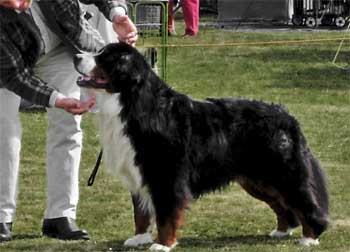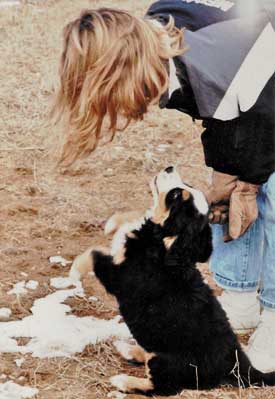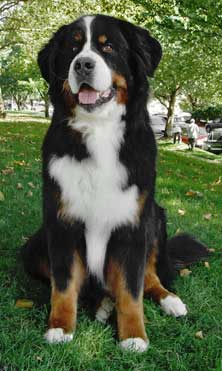Breeding Bernese Bernese Mountain Dogs - set & achieve goals
Sylvia Howison's "Pine Trees, Pails, and Parts"
 So (I asked myself), what advice on breeding can you possibly give to a group of
people who, for the most, are doing such a creditable job with the breed they love? Then
I sat down to watch the "Interviews" tape, and inspiration came from Julia Crawford's
grandfather. Which reminded me of advice from my grandfather and from another old
friend whom I knew long before there was a BMDCA. So I bring you advice that is not
about the science of breeding but, rather, on how to set and achieve goals.
So (I asked myself), what advice on breeding can you possibly give to a group of
people who, for the most, are doing such a creditable job with the breed they love? Then
I sat down to watch the "Interviews" tape, and inspiration came from Julia Crawford's
grandfather. Which reminded me of advice from my grandfather and from another old
friend whom I knew long before there was a BMDCA. So I bring you advice that is not
about the science of breeding but, rather, on how to set and achieve goals.
PINE TREES
When I was a little girl, my grandfather told me a tale of a farmer who was teaching his son to plow. The young lad hung the reins around his neck, put his hand to the plow, and set off across the field. Along the way, he encountered rocks. He plowed around them as best he could, and watched carefully just ahead of him to avoid hitting any more. When he came to the end of his furrow and turned to go back, he found, to his dismay, that the furrow he had just done was not straight like his father's. Rather, it wavered and wandered across the field. His second furrow was no better. "Why is your line so straight and mine so crooked?" he asked his father. "Son," replied the wise old man, "see that pine tree across the field? When I plow, I fix my eyes on the pine tree and plow straight toward it. I never look elsewhere. That is why my furrows are straight." The youngster replied that he could not do that because he had to watch for rocks. His father told him that if his hand was firm on the plow, and his mules were pulling together, the rocks would be rolled aside.
 Successful breeding consists of setting a goal and never taking your eyes from it.
Your goal need not be the same as anyone else's, but you must know what it is. Perhaps
you would like to produce dogs with the most correct coat, the darkest eyes, the best
temperament, or the heaviest bone. Of course, you will pay attention to other aspects of
your animals (a firm hand on the plow and well-trained mules), but you must never
compromise on the goal you have set.
Successful breeding consists of setting a goal and never taking your eyes from it.
Your goal need not be the same as anyone else's, but you must know what it is. Perhaps
you would like to produce dogs with the most correct coat, the darkest eyes, the best
temperament, or the heaviest bone. Of course, you will pay attention to other aspects of
your animals (a firm hand on the plow and well-trained mules), but you must never
compromise on the goal you have set.
PAILS
Julia Crawford's grandfather had this advice for her: "Pick up your pail and go to the
next cow." Presumably what he meant was that there is no point in crying over spilt milk.
In breeding there will be many times when your careful plans will come to naught. When
the bitch that is the apple of your eye does not produce the things that you need from
her, "pick up your pail and go to the next cow." No matter how well bred, no matter how
carefully mated, some animals just do not produce. If two litters do not move you forward
in your plans, find another animal. Too many breeders persist in breeding the same dog
or bitch over and over with a change of mates in the hope that eventually they will get
something good. A good breeding animal should produce not just average animals but
superior ones. It is well to note that the big show winners are not necessarily the best
producers.  Some excellent producers have never seen a show ring. The old adage "if
you like the get, breed to the sire" is still good advice. And if that doesn't work, there's
always another cow.
Some excellent producers have never seen a show ring. The old adage "if
you like the get, breed to the sire" is still good advice. And if that doesn't work, there's
always another cow.
PARTS
Some 35 years ago, when I was very new to the wonderful world of dogs, I heard a grizzled oldtimer say to his companion, "Look at that dog! He is greater than the sum of his parts." It took me a few more years to understand what he meant. No dog is perfect. All of them have a fault-or two or three. But every now and again a dog comes along that takes your breath away. The dog will not be perfect, either, but somehow this one is far and away better than the rest.
While the rest of the world is busy tearing apart and faulting every dog they see, train your eye to look for that special something that defies description. Learn to see the whole that "is greater than the sum of its parts." Particularly learn to look beyond the humans associated with individual dogs, be they acceptable or unacceptable to you, and see only the dogs. Try to see, in every dog, the assets first and the faults later. If you follow this precept long enough, one day, like a picture that suddenly snaps into focus, you will find that you are seeing a dog that has that special something that makes it a truly superb representative of its breed. If you can fit into your breeding program that dog, or the genes that produced that dog, you may find that you also have a truly spectacular "parts" dog.
In summary, my advice to breeders is: Keep your eye on the pine tree; pick up your pail and go to the next cow; and learn to see the whole that is greater than the sum of the parts.